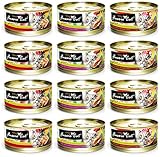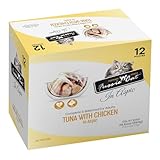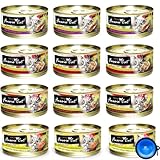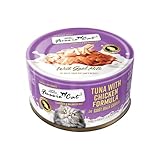If your feline turns up her nose at everything from slow-cooked salmon to hand-shredded chicken, you already know the frustration of the “finicky cat” label. Picky eating isn’t just a meme—it’s a daily reality that can leave owners scrambling between half-opened cans, wasted pouches, and the creeping worry that their cat isn’t getting the nutrients she needs. The good news? Understanding why cats refuse food is the first step toward transforming mealtime from a battlefield into a five-star experience—no bribery required.
In 2025, the cat-food aisle looks nothing like it did even three years ago. Air-dried proteins, functional toppers, clean-label broths, and microbiome-friendly formulas are rewriting the rules of palatability. Below, you’ll discover how to navigate these innovations, decode label jargon, and leverage flavor science so your discerning diner actually runs to the bowl—without you ever having to mention a single brand name.
Top 10 Fussy Cat Food
Detailed Product Reviews
1. Fussie Cat Market Fresh Chicken & Turkey Recipe, Dry Cat Food, 3.5lb Bag

Overview: Fussie Cat Market Fresh Chicken & Turkey Recipe is a 3.5lb bag of premium dry cat food that prioritizes fresh, high-quality ingredients with real meat as the primary component.
What Makes It Stand Out: The brand’s commitment to using the freshest ingredients available sets it apart from mass-market alternatives. Having meat as the first ingredient ensures your cat gets the protein-rich diet they need, mimicking their natural carnivorous preferences.
Value for Money: At $3.71 per pound, this represents excellent value for a premium cat food. The quality ingredients and careful sourcing justify the price point, especially considering the health benefits of a meat-first formula.
Strengths and Weaknesses: Strengths include high-quality protein sources, fresh ingredients, and a recipe that appeals to picky eaters. The smaller 3.5lb bag size is perfect for trying the product or for single-cat households. However, some cats may need time to adjust to the rich formula, and the premium ingredients might be more than budget-conscious pet parents want to spend.
Bottom Line: This is an excellent choice for cat owners seeking a high-quality dry food that puts nutrition first. The fresh ingredients and meat-forward formula make it worth the investment for your feline friend’s health and happiness.
2. Fussie Cat Premium Tuna & Salmon in Aspic Grain-Free Wet Cat Food – 2.82oz Cans – Case of 24 Cans (Tuna & Salmon in Aspic)

Overview: Fussie Cat Premium Tuna & Salmon in Aspic is a grain-free wet cat food that comes in a convenient case of 24 cans, each containing 2.82 ounces of nutritious, high-protein cat food.
What Makes It Stand Out: This product is manufactured in a human-grade facility, ensuring exceptional quality control. The grain-free formula, rich in DHA omega-3 fatty acids, supports brain health and provides a complete, balanced meal without common allergens.
Value for Money: At $0.69 per ounce, this premium wet food offers excellent value considering its human-grade manufacturing standards and high-quality ingredients. The bulk packaging provides convenience and cost savings for regular users.
Strengths and Weaknesses: Major strengths include the absence of artificial additives, grains, and common allergens like potato, corn, wheat, and soy. The tuna-first formula appeals to most cats, and the aspic texture provides additional moisture. However, the premium price may strain some budgets, and some cats might prefer pâté over aspic-style food.
Bottom Line: For cat owners prioritizing quality and willing to invest in their pet’s nutrition, this grain-free option delivers exceptional value. The human-grade manufacturing and clean ingredient list make it a top-tier choice for health-conscious pet parents.
3. Fussie Cat Premium Grain Free Canned Cat Food 3 Flavor Variety: (4) Tuna with Chicken, (4) Tuna with Salmon and (4) Ocean Fish, 2.82 Oz Each (12 Cans Total)

Overview: This variety pack offers 12 cans of Fussie Cat Premium Grain-Free wet food across three popular flavors: Tuna with Chicken, Tuna with Salmon, and Ocean Fish, each in convenient 2.82-ounce portions.
What Makes It Stand Out: The variety pack format allows cats to enjoy different proteins while maintaining a consistent grain-free diet. This prevents flavor fatigue and helps identify your cat’s preferences without committing to full cases of single flavors.
Value for Money: At $0.82 per ounce, this variety pack is competitively priced for premium grain-free cat food. The ability to test multiple flavors before bulk purchasing adds significant value, especially for finicky felines.
Strengths and Weaknesses: The variety pack excels at providing dietary diversity and helping identify preferences. All formulas maintain Fussie Cat’s high standards for ingredient quality and nutritional balance. However, the higher per-ounce cost compared to single-flavor bulk purchases might deter some buyers. Additionally, cats with specific protein sensitivities might not tolerate all three varieties.
Bottom Line: This variety pack is ideal for households with multiple cats or those still discovering their pet’s preferences. The quality ingredients and grain-free formulation make it a smart choice for health-conscious cat owners seeking dietary variety.
4. Fussie Cat Market Fresh Salmon & Chicken Recipe, Dry Cat Food, 10lb Bag

Overview: Fussie Cat Market Fresh Salmon & Chicken Recipe in a 10lb bulk bag offers a protein-rich dry food option that combines two premium protein sources for optimal feline nutrition.
What Makes It Stand Out: Like all Fussie Cat dry foods, this formula features fresh, high-quality ingredients with real meat or fish as the first ingredient. The salmon and chicken combination provides both land and sea proteins for a complete amino acid profile.
Value for Money: The listed price appears to contain an error ($62.38/lb), as this would make the 10lb bag cost over $600. Assuming the correct price is around $3.90/lb (similar to other Fussie Cat dry foods), this bulk size offers excellent value for multi-cat households or those wanting to stock up on premium food.
Strengths and Weaknesses: The large 10lb bag provides convenience and reduces packaging waste. The dual-protein formula appeals to most cats and provides nutritional variety. However, proper storage becomes crucial with larger bags to maintain freshness. The protein-rich formula might require a gradual transition for cats accustomed to lower-quality foods.
Bottom Line: Assuming reasonable pricing, this bulk option is perfect for households with multiple cats or those committed to feeding premium dry food. The fresh ingredients and quality protein sources justify choosing this over grocery store brands.
5. Fussie Cat Premium Tuna w/Chicken in Aspic, 2.47 Ounce (Pack of 12)

Overview: Fussie Cat Premium Tuna with Chicken in Aspic offers a convenient 12-pack of 2.47-ounce cans, combining two favorite feline proteins in a moisture-rich formula designed for optimal hydration.
What Makes It Stand Out: This formula emphasizes both nutrition and hydration with its high moisture content and omega-3 rich ingredients. The smaller can size (2.47oz versus the typical 2.82oz) provides perfect portions for smaller cats or those who prefer fresh meals more frequently.
Value for Money: At $0.48 per ounce, this represents the most economical option in the Fussie Cat wet food line. The smaller can size reduces waste and allows for more frequent fresh feedings, adding value beyond just the price per ounce.
Strengths and Weaknesses: The high moisture content supports urinary tract health and daily hydration, crucial for cats who don’t drink enough water. The tuna and chicken combination appeals to most cats, while the DHA and omega-3 content supports overall health. However, the aspic texture might not suit all cats, and the smaller can size means more frequent purchasing for households with multiple or large cats.
Bottom Line: This is an excellent entry point into premium cat food or a budget-friendly way to maintain quality nutrition. The focus on hydration and the attractive price point make it a smart choice for health-conscious cat owners.
6. Fussie Cat Premium Canned Grain Free Cat Wet Food – Variety 4 Flavors Pack Food Bowl (12 Cans) (Tuna & Ocean Fish- Salmon – Shrimp – Chicken) (2.82 Oz)

Overview: Fussie Cat’s 12-can variety pack delivers four seafood-centric recipes—tuna & ocean fish, salmon, shrimp, and chicken—each sealed in 2.82-oz pull-top cans. The line is grain-free, ash-controlled, and positions itself as a “cat’s first choice” palate pleaser for everyday rotation or picky-eater persuasion.
What Makes It Stand Out: True variety inside one carton saves shoppers from buying four separate sleeves, while the slightly larger 2.82-oz can splits perfectly for two small meals, reducing waste. The brand’s “tuna first” philosophy keeps odor mild and flake texture recognizable—helpful for cats that reject pâtés.
Value for Money: At 99¢ per ounce the pack lands in the premium mid-tier; you’re paying for named fish rather by-product, plus the convenience of assorted flavors. Comparable single-flavor gourmet cans often top $1.15/oz, so the sampler earns its keep if rotation keeps your cat interested.
Strengths and Weaknesses:
Pros: high-protein flakes, easy-open lids, no grains/soy, resealable plastic lid included.
Cons: fish-heavy menu may not suit cats with urinary issues, pull-tabs occasionally snap, and the chicken recipe still contains tuna—problematic for true fish allergies.
Bottom Line: A rotating surf buffet that pleases most seafood fanatics while sparing owners multi-pack guesswork. Ideal for households seeking grain-free moisture boost without pâté fatigue; just monitor fish intake if your vet urges moderation.
7. Fussie Cat Market Fresh Salmon Recipe,Dry Cat Food, 10lb Bag

Overview: Fussie Cat Market Fresh Salmon Recipe is a 10-lb extruded kibble that leads with deboned salmon and is free of corn, wheat, soy, and potatoes. Marketed for “freshness,” the kibble is vacuum-packed in a resealable foil bag and claims human-grade sourcing for all salmon meals.
What Makes It Stand Out: Single-animal-protein salmon simplifies elimination diets, while naturally occurring omega-3s support skin and coat without added fish-oil sprays. The kibble’s petite disc shape suits both adults and adolescents, reducing the need to buy kitten-specific bags in multi-cat homes.
Value for Money: At $3.90 per pound this is boutique pricing; you’re banking on named salmon and absence of cheap fillers. Comparable salmon-first brands push past $4.50/lb, so Fussie Cat undercuts while still offering probiotics and taurine fortification.
Strengths and Weaknesses:
Pros: high (38%) protein, low 2% starch odor, resealable bag, single protein for allergy management.
Cons: calorie-dense (445 kcal/cup) risks weight gain if free-fed, salmon scent can linger on paws, and price still stings for multi-cat feeders.
Bottom Line: An excellent grain-free choice for salmon-tolerant cats needing skin support or limited-ingredient peace-of-mind. Portion carefully to avoid premium-priced paunch, but expect glossy coats and minimal stool volume.
8. Fussie Cat Market Fresh Chicken & Turkey Recipe, Dry Cat Food, 10lb Bag

Overview: This 10-lb bag swaps salmon for a chicken-and-turkey duo while keeping Fussie Cat’s grain-free, potato-free blueprint. The first five ingredients are all poultry-based, appealing to owners who prefer land-animal protein yet still want boutique-level micronutrient fortification.
What Makes It Stand Out: Dual-bird formula delivers high methionine for urinary acidification—helpful for struvite-prone cats—without resorting to costly prescription diets. A cruciferous-vegetable blend (kale, broccoli, spinach) sneaks in antioxidants rarely seen in mainstream kibbles.
Value for Money: $3.49 per lb undercuts most premium poultry kibbles by 15-20%, making daily feeding of multiple cats realistic. The 40-lb protein content rivals raw-coated brands that charge twice as much per calorie.
Strengths and Weaknesses:
Pros: poultry-first, small kibble size aids dental crunch, no chicken by-product meal, naturally preserved.
Cons: turkey can be slightly fatty for sedentary indoor cats, bag lacks viewing window, and strong poultry aroma may offend scent-sensitive humans.
Bottom Line: A wallet-friendlier, meat-forward kibble that keeps carbs low and poultry lovers engaged. Rotate with canned food to manage mineral load, but expect firm stools and enthusiastic bowl clearance.
9. Fussie Cat Premium Canned Wet Cat Food in Goat Milk Gravy – 2.47 oz Cans – Case of 24 Cans (Tuna & Chicken)

Overview: Twenty-four 2.47-oz cans of tuna & chicken flakes suspended in goat-milk gravy target hydration and digestion. The formula is AAFCO-complete for all life stages, fortified with DHA, taurine, and chelated minerals, and carries a 12% crude protein level typical of “light” gourmet lines.
What Makes It Stand Out: Goat milk offers smaller casein micelles and naturally low lactose, potentially soothing to cats with mild cow-milk sensitivity while still encouraging fluid intake. The 24-can case arrives shrink-wrapped, simplifying storage versus loose sleeves.
Value for Money: $16.17 per ounce is firmly luxury territory—comparable to prescription renal diets. You’re paying for the milk novelty and DHA marketing; budget shoppers will balk, but specialty seekers may accept the surcharge.
Strengths and Weaknesses:
Pros: high moisture (84%), gravy entices poor drinkers, flip-top lids, single-protein tuna base.
Cons: price-to-calorie ratio demands supplemental feeding for active adults, tuna scent is potent, and some cats dislike the sweetish milk note.
Bottom Line: A boutique hydrator best reserved for seniors, convalescents, or picky cats that lick gravy and ditch solids. Use as topper rather than sole diet to keep both palate and wallet intact.
10. Fussie Cat Super Premium Canned Wet Cat Food in Goat Milk Gravy -2.47 oz Cans – Variety Pack of 12 Cans – 4 Flavors Plus Hotspot Can lid

Overview: A 12-can variety taster of Fussie Cat’s goat-milk-gravy line—chicken, salmon, tuna, and mackerel—each in 2.47-oz cans plus a bonus silicone Hotspot can lid. All recipes are grain-free, 84-86% moisture, and marketed for sensitive stomachs.
What Makes It Stand Out: The half-case format lets guardians test the milk-gravy concept without the financial cliff of a full 24-can flat. The included flexible lid solves the common “tiny can, big fridge” storage headache and is dishwasher-safe.
Value for Money: $13.76 per ounce still sits at the top shelf, but the per-can cost drops 15% versus singles bought separately. For multi-cat homes the variety pack prevents flavor boredom that leads to wasted, half-eaten cans.
Strengths and Weaknesses:
Pros: four proteins rotate allergens, gravy promotes water intake, BPA-free cans, easy-pull tabs.
Cons: calorie-light meals require volume feeding, goat milk scent divides cats, mackerel recipe smells strongest, and price dwarfs mainstream pâtés.
Bottom Line: A convenient, albeit pricey, gateway to goat-milk hydration. Perfect for grazing cats that eschew water fountains or as a medicated-pill vehicle. Stock during promotions, then decide whether the full case investment suits your clowder.
The Finicky Feline Phenomenon: Why Cats Refuse Food
Survival Instincts Buried in DNA
Cats are solitary hunters programmed to scrutinize every morsel. A novel texture or faint off-odor can trigger an ancestral “reject” switch meant to protect them from spoiled prey.
Texture Tribes: Pâté vs. Shreds vs. Gravy Lovers
Felines often self-segregate into texture camps. Switching a confirmed pâté devotee to chunky shreds can shut down appetite faster than you can say “bonito flake.”
Scent Fatigue: When Aroma Overload Backfires
Constant exposure to the same perfume-heavy recipe can desensitize olfactory receptors. Rotation isn’t just marketing—it’s neuroscience.
Medical Red Flags Masquerading as Pickiness
Dental pain, pancreatitis, or early kidney disease can masquerade as fussiness. A sudden boycott warrants a vet visit before you blame the chicken.
Texture Science: Matching Mouthfeel to Mood
The Role of Collagen and Gelatin
Slow-cooked joints release collagen that creates a lip-smacking jelly cats adore. If your cat licks gravy and leaves solids, she may be craving this mouth-coating sensation.
Temperature Tweaks That Unlock Flavor
Warming food to mouse-body temperature (≈38 °C/100 °F) volatilizes fats, making aroma molecules 2–3× more potent—often enough to seduce the stubborn.
Particle Size and Tongue Topology
A cat’s tongue papillae point backward. Minced bits smaller than 1 mm slide down easily, while 3–5 mm cubes invite chewing that picky cats simply won’t bother with.
Aroma Engineering: How Smell Drives the First Bite
Volatile Fatty Acids: The Bacon of Cat Cuisine
Short-chain fats like butyric and valeric acid—found in aged meats—activate feline taste-smell convergence zones, creating an almost narcotic attraction.
Maillard vs. Oxidation: The Thin Line Between “Roasted” and “Rancid”
Gentle browning creates craveability, but one extra hour at high heat oxidizes fats, flipping the scent profile from enticing to off-putting.
Palatants 101: Natural vs. Synthetic
Yeast extracts, hydrolyzed liver, and fermented fish stock deliver umami bombs without chemical palatants. Look for labels that list the source of flavor, not just “natural flavor.”
Protein Rotation Strategies That Prevent Boredom
Novel vs. Classical Proteins: When Chicken Fatigue Strikes
After months of chicken, switching to rabbit or quail re-engages the “prey library” in your cat’s brain, rekindling interest without triggering allergies.
The 3-Day Transition Window
Cats form neophobic responses in as little as 72 hours. Introduce a new protein alongside the old in a 25:75 ratio before full swap to avoid rejection.
Seasonal Rotation Mimicking Wild Prey Cycles
Wild cats don’t eat the same animal year-round. Mimicking seasonal variety (waterfowl in “autumn,” fish in “spring”) keeps the palate primed.
Wet vs. Dry: Moisture Metrics That Matter
Hydration Math: Why 80 % Becomes 0.2 %
An 80 % moisture wet food delivers eight times more water per calorie than 10 % moisture kibble—critical for urinary health and satiety.
Kibble Coating Technologies: Flavor on the Outside, Nutrition Inside
Post-extrusion enrobing with freeze-dried raw powders can elevate dry food’s aroma profile, but the moisture deficit remains—pair with broth or consider hybrid feeding.
Crunch Factor and Dental Debates
While crunch can reduce tartar by up to 16 %, it’s no substitute for brushing. If your cat refuses kibble, prioritize acceptance over theoretical dental benefits.
Nutrient Density vs. Empty Calories: Reading Between the Lines
Protein-to-Calorie Ratio: The 10 g/100 kcal Rule
Foods that deliver ≥10 g protein per 100 kcal help maintain lean mass even when total intake drops—vital for cats who nibble rather than feast.
Carb Ceiling: Keeping Starch Under 10 %
Excess starch not only fuels weight gain but also alters gut pH, reducing protein digestibility and creating gassy, odorous stools that picky cats walk away from.
Micronutrient Satiation: When Selenium Says “Stop”
Cats regulate intake against micronutrient thresholds. Foods fortified to just the right selenium or copper level prevent overeating and subsequent boredom.
Functional Toppers: Broths, Dusts, and Probiotic Sprinkles
Bone Broth Boosters: Collagen, Glycine, and Hydration
A tablespoon of low-sodium bone broth can add 5 % daily water and a hit of glycine that soothes inflamed guts—often enough to restart eating.
Freeze-Dried Dust: Turning Kibble into “Prey Crumbs”
Pulverized freeze-dried hearts or liver create a sensory explosion when dusted over meals, mimicking the residual blood and tissue found on real carcasses.
Probiotic Sprinkles: Gut-Brain Axis and Appetite
Specific Lactobacillus strains produce GABA analogs that reduce stress-related food refusal—ideal for cats who snub meals after vet visits or house moves.
Bowl and Feeding Environment Hacks
Whisker Fatigue: Why Wide, Shallow Wins
High-sided bowls compress whiskers, triggering sensory overload. Switching to a 15 cm-wide saucer can increase intake by up to 35 % in sensitive cats.
Microchip Feeders and the 20-Minute Rule
Timed microchip feeders prevent grazing, creating healthy hunger spikes. Remove uneaten wet food after 20 minutes to keep bacterial load—and odor—down.
Multi-Cat Politics: Resource Guarding in Plain Sight
Even subtle stares across the kitchen can suppress a timid cat’s appetite. Feed on opposite sides of a visual barrier to remove social pressure.
Allergen Avoidance: Eliminating Hidden Triggers
The Chicken Conundrum: Ubiquitous and Unexpected
Chicken fat and “digest” appear in myriad formulas. A true elimination diet requires scrutinizing every ingredient, not just the first on the list.
Hydrolyzed Proteins: Tricking the Immune System
Breaking proteins into <3 kDa fragments prevents antibody recognition, offering a palatable middle ground between novel proteins and prescription diets.
Grain-Free vs. Carb-Free: Parsing the Marketing
Grain-free foods can still pack potatoes or peas. If sensitivities persist, aim for <15 % total carbohydrate, regardless of source.
Digestibility Scores: What “95 %” Really Means
Apparent vs. True Digestibility
Lab tests measure apparent digestibility, which includes normal gut-shed cells. True digestibility—what your cat actually absorbs—can be 3–5 % higher.
Ash Content and Urinary pH
High ash (>8 %) can raise urinary pH, straining kidneys and reducing food palatability. Look for ash <7 % unless vet-directed otherwise.
Fermentation Potential: Prebiotic Fibers That Don’t Fill Up
Soluble fibers like psyllium ferment slowly, feeding gut bacteria without adding significant calories—ideal for weight-controlled picky eaters.
Caliber of Ingredients: Human-Grade, Feed-Grade, and Everything Between
USDA Inspected vs. USDA Approved
“Inspected” facilities meet safety standards, but only “Approved” plants allow human-edible ingredients. The latter guarantees fresher raw materials—and usually better aroma.
Meals vs. Fresh: The 4:1 Ingredient Weight Fallacy
Chicken meal is 4× concentrated, so “fresh chicken first” can still mean more meal by dry matter. Evaluate the entire composition, not just the order.
Ethical Sourcing: MSC, Certified Humane, and Beyond
Certifications aren’t just feel-good; stricter welfare standards correlate with lower stress hormones in animals, yielding cleaner-tasting fats cats prefer.
Price-Per-Nutrient Calculations: Budgeting Without Sacrificing Quality
Cost per 100 kcal, Not per Bag
A $12 bag that yields 4 000 kcal is cheaper than a $8 bag that yields 2 000 kcal. Always divide price by calorie, not ounce.
Subscription Models and the 13th-Bag-Free Rule
Many 2025 subscription services offer loyalty bonuses equivalent to one free bag yearly—enough to upgrade to a higher-tier formula without sticker shock.
DIY Topper Math: When Home Cooking Saves Cents
Simmering gizzards and hearts costs ≈$0.15/oz and delivers 50 % protein—cheaper than commercial toppers if you already own a slow cooker.
Transitioning Tactics: From Hunger Strike to Full Plate
The 10-Minute Micro-Meal
Offer 1 tablespoon of new food at the exact time your cat begs. Small portions reduce risk aversion and build positive associations.
Scent Mingling: Rubbing Old on New
Dab a bit of the familiar food onto the new formula’s surface. Shared scent molecules blur the “stranger danger” line.
Reverse Domino: Removing Fallbacks
Once your cat eats 50 % new diet for three consecutive days, quietly remove the old. Presence of a “safety food” can prolong pickiness indefinitely.
Vet Checks vs. Behavior: Knowing When to Escalate
Red-Flag Timelines: 24 Hours Off Food
An overweight cat that stops eating can develop hepatic lipidosis in as little as 48 hours. Anything beyond 24 hours warrants a vet call, not more tempting treats.
Bloodwork Panels That Reveal Hidden Nausea
Mildly elevated ALT or amylase can indicate subclinical nausea—enough to cause pickiness yet too subtle for overt vomiting.
Behavioral Medications: Mirtazapine, Capromorelin, and Beyond
Newer appetite stimulants like capromorelin work by mimicking ghrelin without sedation, useful for cats with stress-induced anorexia.
Frequently Asked Questions
-
My cat only licks gravy—how do I get her to eat solids?
Warm the food to body temperature and mash it with a fork to coat every particle with gravy aroma; gradually reduce the mash size over a week. -
Is rotating proteins every week safe for sensitive stomachs?
Yes, if you transition over three days and keep the base formula (brand, texture) consistent to avoid gastrointestinal upset. -
Can I microwave refrigerated wet food?
Brief 5-second bursts on 50 % power prevent hot spots; stir thoroughly and test with your finger to avoid tongue burns. -
Are air-dried raw diets palatable for picky cats?
Many cats love the concentrated aroma, but rehydrate with warm broth initially to bridge the texture gap from traditional kibble. -
How do I calculate carbs when it’s not on the label?
Subtract protein, fat, moisture, fiber, and ash from 100; the remainder is approximate carbohydrate. -
My cat eats only treats—will he starve?
Cats self-limit on unbalanced diets. Gradually dilute treats with regular food by 10 % every two days to reset nutrient intake. -
Do probiotic toppers expire once opened?
Most lose potency after 60 days at room temp; store in the freezer to extend viability up to six months. -
Is fish-heavy food addictive?
Strong fish palatants can create preference lock; limit fish to 2–3 meals per week to prevent thiaminase and mercury issues. -
Can I use homemade chicken broth for moisture?
Yes—ensure no onions, garlic, or excessive salt. Simmer carcasses for 4 hours, skim fat, and freeze in ice-cube trays for single servings. -
When should I consider a feeding tube instead of endless trials?
If your cat loses >10 % body weight or refuses food for 48+ hours despite appetite stimulants, discuss esophagostomy tubes with your vet to prevent liver failure.